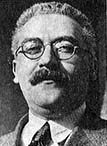PÁTZAY, Pál
(1896, Kapuvár - 1979, Budapest)


Sculptor and art teacher. From 1912 to 1914 he was a pupil of Béla Radnai at the Art School but he was expelled so he went on learning on his own. In 1914 he spent a longer time with the Ferenczy family in Nagybánya, then joined the group led by Kassák in 1915. Eight of his statues were exibited together with pictures of Ede Bohacsek in 1917. As he supported the cultural directorat in the Hungarian Soviet Republic, he was entenced to prison for one year and six months.
Sponsored by Andor Miklós, a publisher, he went on a study trip to France in 1927. He stayed in Rome on thescholarship of the Hungarian Academy in Rome between 1928-30. His works were exhibited together with those of Aba Novák in 1931 when he was awarded the Franz Josef Medal for "Nurse". In 1935 he was commissioned to design the tomb of Ernő Szőts, President of the Hungarian Radio. Two years later "Wind on the Danube" was erected on the Promenade by the Danube, and he was awarded the Grand Prix of the World Exhibition in Paris for the statue of "St. Stephen" in the Hungarian Pavillion. In 1941 he was awarded the Greguss Medal for the "Soldier Memorial" in Székesfehérvár. He was commissioned by Ernő Mihályfy in 1942 to model the Pető Plaquette which was worn by demonstrators of the March Front.
From 1945 onwards he was a leading personality of art life. He was a professor at the Art School from 1945 to 1970. After early expressionism present in plaquettes, statuettes, and medals ("Youth" bronze, 1915, "Male Nude" bronze, 1915), a plastic classicist style and moderate forms characterized his art. His major works include the statue of Bálint Balassi, 1959, the statue of Lenin, 1970, and the "Memorial of the Armoured Troops at World War II" in Debrecen, 1970. "Cutting Bread" created in the 40s was erected in Kapuvár in 1973. His major statuettes and portraits include "Girl Combing Hair" bronze 1919-22, "Sisters" 1933, "Stepping into Water" bronze, 1955, "Aurél Bernáth" bronze, 1958, "Gyula Derkovits" bronze, 1966, and "Zoltán Kodály" bronze 1967. He published several studies on art, e.g. "Chaos of Esthetics" (1962), and "Historical Questions of Arts" (1966).
